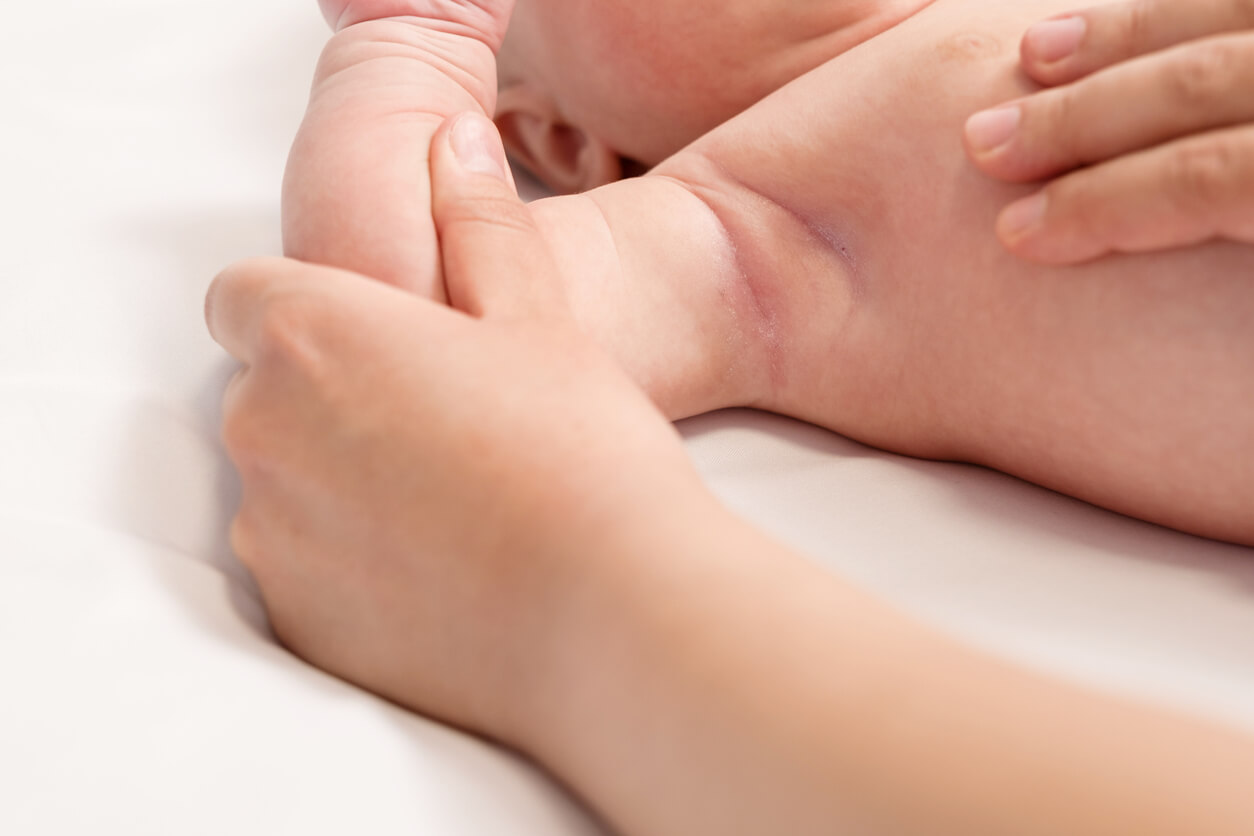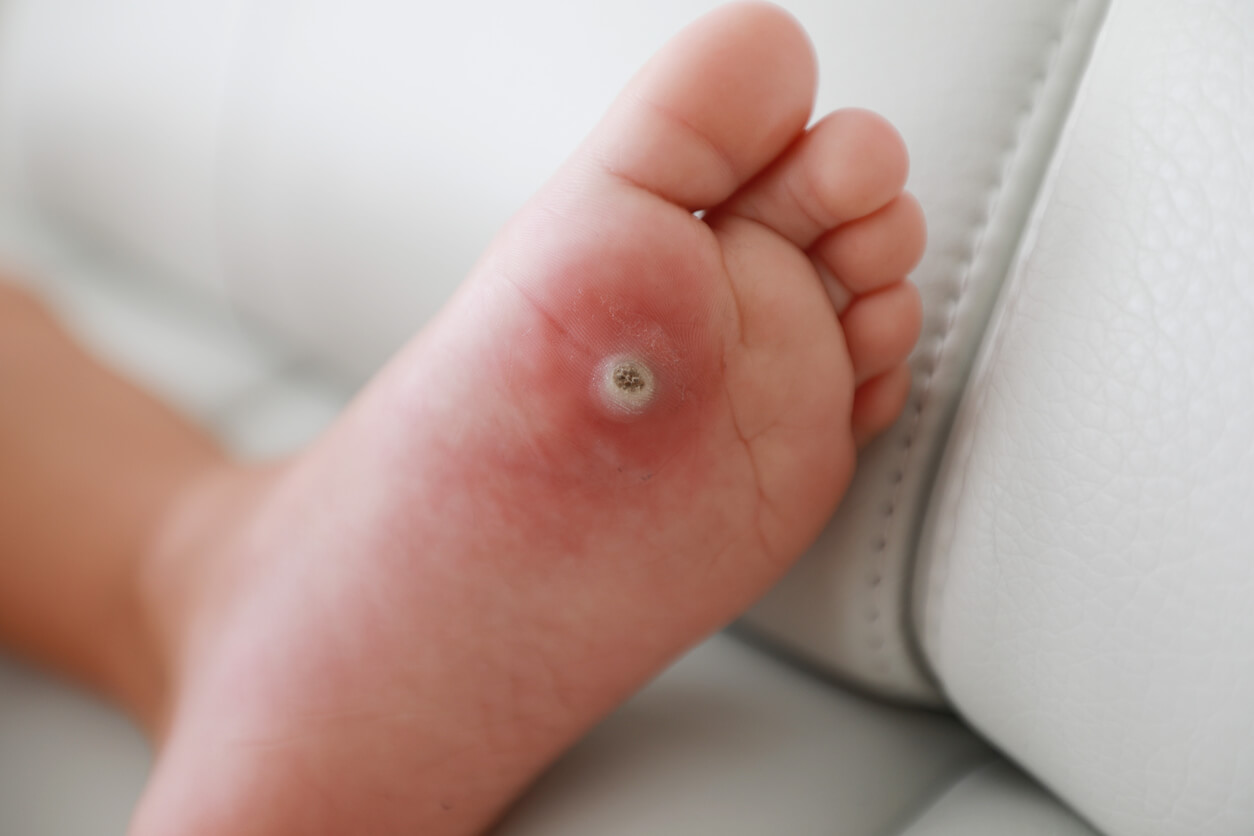10 Childhood Skin Diseases Related to Lack of Hygiene


Written and verified by the dermatologist Maria del Carmen Hernandez
There are several childhood skin diseases caused by a lack of hygiene. The vast majority of diseases are caused by germs that enter the body through water, food, or dirty hands. In this article, we’ll tell you about some of the preventable childhood skin diseases caused by lack of hygiene.
Write down these childhood skin diseases caused by a lack of hygiene
Every day, we’re in contact with different external germs and viruses. These can remain in the body and, in some cases, lead to disease. Hygiene methods help to prevent diseases and keep children healthier.
1. Scabies
Scabies is caused by an infestation of the skin by the mite Sarcoptes scabiei var. hominis . The most characteristic symptoms are intense itching and a rash on the skin’s surface. The mite is transmitted by prolonged and direct skin-to-skin contact with an infected child. Therefore, avoiding poor hygiene is important to control and prevent scabies.
2. Diaper rash
Diaper rash or diaper dermatitis is an acute inflammatory condition characterized by erythema, pustules, and papules in the diaper area. It’s caused by a combination of multiple factors, such as increased moisture, prolonged contact with fecal matter or urine, and other irritants.

3. Pediculosis
Lice are parasites that can be located on the neck and head. They survive by feeding on the blood of their host and are transmitted by close contact from child to child. Proper hygiene is important to help control and prevent the spread of head lice.
You may be interested in: Does Apple Cider Vinegar Work Against Lice?
4. Tinea pedis
Tinea pedis or athlete’s foot is an infection of the skin surface that can be developed by different types of fungi. While it can affect any part of the foot, most cases are found in the interdigital space. It’s characterized by scales or fissures that may cause itching or redness. In addition, its transmission is by contact with infected skin or causative agents in humid areas (showers, swimming pools, or locker rooms).
5. Bromhidrosis due to poor hygiene
Bromhidrosis is defined as body odor related to sweating. In fact, perspiration itself is odorless. Bad smells occur when it comes into contact with bacteria on the skin. Apocrine glands are found in the armpit, groin, and breast areas and aren’t activated until puberty. Their management or prevention is through changes in hygiene habits. Also, there are medical treatments for it.
6. Pseudomonas dermatitis
Also known as Pseudomonas aeruginosa folliculitis, this is a skin infection. This germ is most commonly found in the environment (soil, water) and is transmitted by direct skin contact with contaminated water.
Symptomatology includes itchy skin that may progress to a red rash and pus-filled blisters around the hair follicles. In most cases, the rashes tend to disappear on their own, within a few days and without medical treatment.
Read also: 10 Home Remedies to Eliminate Foot Odor
7. Impetigo
This is a common infection of the superficial layers of the epidermis. It’s also very contagious and spreads easily. In most cases, it presents as erythematous plaques with a yellow crust. It may also cause itching or pain. Washing hands with antiseptic or plain soap greatly reduces the chances of contracting infections such as diarrhea, pneumonia, and impetigo.

8. Molluscum contagiosum
Also known as water warts, this is a benign, contagious skin condition. Transmission is by direct skin-to-skin contact or indirect contact via underwear, towels, toys, etc.). In addition, they’re usually asymptomatic and are located on the skin and mucous membranes of the face or extremities and armpits, according to a review in Dermatology Online Journal.
9. Warts
Warts are benign vegetations generated by the human papillomavirus (HPV) that develop on the skin and mucosa. Transmission to any part of the body is through skin contact. Therefore, they’re easily transmitted by direct or indirect contact, especially if the normal epithelial barrier is broken. Therefore, lack of hygiene is a risk factor.
10. Dermatophytosis
Ringworm is an infectious disease of the skin caused by a fungus. It’s characterized by the appearance of an itchy, red, circular rash. The fungus that causes the condition can be located on the skin, surfaces, and household items such as clothing, bedding, and towels.
Personal hygiene contributes to a child’s health
Teaching good personal hygiene habits protects young children from the threat of disease and germs. It even helps to keep them healthy without requiring too many visits to a medical specialist.
There are several childhood skin diseases caused by a lack of hygiene. The vast majority of diseases are caused by germs that enter the body through water, food, or dirty hands. In this article, we’ll tell you about some of the preventable childhood skin diseases caused by lack of hygiene.
Write down these childhood skin diseases caused by a lack of hygiene
Every day, we’re in contact with different external germs and viruses. These can remain in the body and, in some cases, lead to disease. Hygiene methods help to prevent diseases and keep children healthier.
1. Scabies
Scabies is caused by an infestation of the skin by the mite Sarcoptes scabiei var. hominis . The most characteristic symptoms are intense itching and a rash on the skin’s surface. The mite is transmitted by prolonged and direct skin-to-skin contact with an infected child. Therefore, avoiding poor hygiene is important to control and prevent scabies.
2. Diaper rash
Diaper rash or diaper dermatitis is an acute inflammatory condition characterized by erythema, pustules, and papules in the diaper area. It’s caused by a combination of multiple factors, such as increased moisture, prolonged contact with fecal matter or urine, and other irritants.

3. Pediculosis
Lice are parasites that can be located on the neck and head. They survive by feeding on the blood of their host and are transmitted by close contact from child to child. Proper hygiene is important to help control and prevent the spread of head lice.
You may be interested in: Does Apple Cider Vinegar Work Against Lice?
4. Tinea pedis
Tinea pedis or athlete’s foot is an infection of the skin surface that can be developed by different types of fungi. While it can affect any part of the foot, most cases are found in the interdigital space. It’s characterized by scales or fissures that may cause itching or redness. In addition, its transmission is by contact with infected skin or causative agents in humid areas (showers, swimming pools, or locker rooms).
5. Bromhidrosis due to poor hygiene
Bromhidrosis is defined as body odor related to sweating. In fact, perspiration itself is odorless. Bad smells occur when it comes into contact with bacteria on the skin. Apocrine glands are found in the armpit, groin, and breast areas and aren’t activated until puberty. Their management or prevention is through changes in hygiene habits. Also, there are medical treatments for it.
6. Pseudomonas dermatitis
Also known as Pseudomonas aeruginosa folliculitis, this is a skin infection. This germ is most commonly found in the environment (soil, water) and is transmitted by direct skin contact with contaminated water.
Symptomatology includes itchy skin that may progress to a red rash and pus-filled blisters around the hair follicles. In most cases, the rashes tend to disappear on their own, within a few days and without medical treatment.
Read also: 10 Home Remedies to Eliminate Foot Odor
7. Impetigo
This is a common infection of the superficial layers of the epidermis. It’s also very contagious and spreads easily. In most cases, it presents as erythematous plaques with a yellow crust. It may also cause itching or pain. Washing hands with antiseptic or plain soap greatly reduces the chances of contracting infections such as diarrhea, pneumonia, and impetigo.

8. Molluscum contagiosum
Also known as water warts, this is a benign, contagious skin condition. Transmission is by direct skin-to-skin contact or indirect contact via underwear, towels, toys, etc.). In addition, they’re usually asymptomatic and are located on the skin and mucous membranes of the face or extremities and armpits, according to a review in Dermatology Online Journal.
9. Warts
Warts are benign vegetations generated by the human papillomavirus (HPV) that develop on the skin and mucosa. Transmission to any part of the body is through skin contact. Therefore, they’re easily transmitted by direct or indirect contact, especially if the normal epithelial barrier is broken. Therefore, lack of hygiene is a risk factor.
10. Dermatophytosis
Ringworm is an infectious disease of the skin caused by a fungus. It’s characterized by the appearance of an itchy, red, circular rash. The fungus that causes the condition can be located on the skin, surfaces, and household items such as clothing, bedding, and towels.
Personal hygiene contributes to a child’s health
Teaching good personal hygiene habits protects young children from the threat of disease and germs. It even helps to keep them healthy without requiring too many visits to a medical specialist.
All cited sources were thoroughly reviewed by our team to ensure their quality, reliability, currency, and validity. The bibliography of this article was considered reliable and of academic or scientific accuracy.
- Fimiani M, Mazzatenta C, Alessandrini C, Paccagnini E, Andreassi L. The behaviour of Sarcoptes scabiei var. hominis in human skin: an ultrastructural study. J Submicrosc Cytol Pathol. 1997 Jan;29(1):105-13. PMID: 9066149.
- Ko CJ, Elston DM. Pediculosis. J Am Acad Dermatol. 2004 Jan;50(1):1-12; quiz 13-4. doi: 10.1016/s0190-9622(03)02729-4. PMID: 14699358.
- Hewitt DJ, Weeks DA, Millner GC, Huss RG. Industrial Pseudomonas folliculitis. Am J Ind Med. 2006 Nov;49(11):895-9. doi: 10.1002/ajim.20391. PMID: 17036348.
- Hanson D, Diven DG. Molluscum contagiosum. Dermatol Online J. 2003 Mar;9(2):2. PMID: 12639455.
This text is provided for informational purposes only and does not replace consultation with a professional. If in doubt, consult your specialist.








